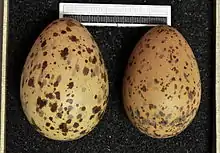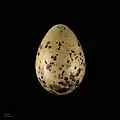Lesser black-backed gull
The lesser black-backed gull (Larus fuscus) is a large gull that breeds on the Atlantic coasts of Europe. It is migratory, wintering from the British Isles south to West Africa. It has increased dramatically in North America, most common along the east coast. Formerly just a winter visitor, many birds are now spotted year-round. Some winters they occur in large numbers. Even on the west coast, this species has become an annual winter visitor in California with birds reported around most of the state each winter. They've even been seen in numbers at the Salton Sea. There is now serious concern about declines in many parts of the species range. The species is now on the RSPB Amber List[2] because the UK is home to 40 per cent of the European population and more than half of these are found at fewer than ten sites.[3]
| Lesser black-backed gull | |
|---|---|
 | |
| Larus fuscus graellsii | |
| Scientific classification | |
| Domain: | Eukaryota |
| Kingdom: | Animalia |
| Phylum: | Chordata |
| Clade: | Dinosauria |
| Class: | Aves |
| Order: | Charadriiformes |
| Family: | Laridae |
| Genus: | Larus |
| Species: | L. fuscus |
| Binomial name | |
| Larus fuscus | |
 | |
Taxonomy
The lesser black-backed gull was one of the many species originally described by Carl Linnaeus in his 1758 10th edition of Systema Naturae, and it still bears its original name Larus fuscus.[4] The scientific name is from Latin. Larus appears to have referred to a gull or other large seabird, and fuscus meant black or brown.[5]
Subspecies
The five recognized subspecies are:
- L. f. graellsii Brehm, 1857: Greenland, Iceland, Faroe Islands, British Isles, western Europe - mantle dark grey
- L. f. intermedius Schiøler, 1922: Netherlands, Germany, Denmark, southwest Sweden and western Norway - mantle sooty black
- L. f. fuscus Linnaeus, 1758: northern Norway, Sweden and Finland to the White Sea - mantle jet black
- L. f. heuglini Bree, 1876: northern Russia to north-central Siberia, known as Heuglin's gull, this was previously considered a separate species.
- L. f. barabensis Johansen, 1960: central Asia
Description
The lesser black-backed gull is smaller than the European herring gull. The taxonomy of the herring gull / lesser black-backed gull complex is very complicated; different authorities recognise between two and eight species. This group has a ring species distribution around the Northern Hemisphere. Differences between adjacent forms in this ring are fairly small, but by the time the circuit is completed, the end members, herring gull and lesser black-backed gull, are clearly different species. The lesser black-backed gull measures 51–64 cm (20–25 in), 124–150 cm (49–59 in) across the wings, and weighs 452–1,100 g (0.996–2.425 lb), with the nominate race averaging slightly smaller than the other two subspecies.[6] Males, at an average weight of 824 g (1.817 lb), are slightly larger than females, at an average of 708 g (1.561 lb). Among standard measurements, the wing chord is 38 to 45 cm (15 to 18 in), the bill is 4.2 to 5.8 cm (1.7 to 2.3 in), and the tarsus is 5.2 to 6.9 cm (2.0 to 2.7 in).[7][8][9] A confusable species is the great black-backed gull. The lesser is a much smaller bird, with slimmer build, yellow rather than pinkish legs, and smaller white "mirrors" at the wing tips. The adults have black or dark grey wings (depending on race) and back. The bill is yellow with a red spot at which the young peck, inducing feeding (see fixed action pattern). The head is greyer in winter, unlike great black-backed gulls. Annual moult for adults begins between May and August and is not complete on some birds until November. Partial prebreeding moult occurs between January and April.[10]
Young birds have scaly black-brown upperparts and a neat wing pattern. They take four years to reach maturity. Identification from juvenile herring gulls is most readily done by the more solidly dark (unbarred) tertial feathers.
Their call is a "laughing" cry like that of the herring gull, but with a markedly deeper pitch.
Breeding
This species breeds colonially on coasts and lakes, making a lined nest on the ground or a cliff. Normally, three eggs are laid. In some cities, the species nests within the urban environment, often in association with herring gulls.[11]

Feeding
They are omnivores like most Larus gulls, and they eat fish, insects, crustaceans, worms, starfish, molluscs, seeds, berries, small mammals, eggs, small birds, chicks, scraps, offal, and carrion.
Gallery
References
- BirdLife International (2019). "Larus fuscus". IUCN Red List of Threatened Species. 2019: e.T22694373A155594163. doi:10.2305/IUCN.UK.2019-3.RLTS.T22694373A155594163.en. Retrieved 12 November 2021.
- "Endangered Birds | Red, Amber and Green Explained".
- "Lesser Black Backed Gull Facts | Larus Fuscus".
- Linnaeus, C. (1758). Systema naturae per regna tria naturae, secundum classes, ordines, genera, species, cum characteribus, differentiis, synonymis, locis. Tomus I. Editio decima, reformata (in Latin). Vol. 1. Holmiae [Stockholm]: (Laurentii Salvii). p. 136.
- Jobling, James A (2010). The Helm Dictionary of Scientific Bird Names. London: Christopher Helm. pp. 167, 219. ISBN 978-1-4081-2501-4.
- "Lesser black-backed gull". All About Birds. Cornell Lab of Ornithology.
- Olsen, Klaus Malling; Larsson, Hans (2004). Gulls: Of North America, Europe, and Asia. Princeton University Press. ISBN 978-0691119977.
- Harrison, Peter (1991). Seabirds: An Identification Guide. Houghton Mifflin Harcourt. ISBN 978-0-395-60291-1.
- Dunning, John B. Jr., ed. (1992). CRC Handbook of Avian Body Masses. CRC Press. ISBN 978-0-8493-4258-5.
- RSPB Handbook of British Birds (2014). UK ISBN 978-1-4729-0647-2
- "The Urban Gull – a new phenomenon". Retrieved 15 September 2009.
External links
- Lesser black-backed gull pages on www.gull-research.org
- Lesser black-backed gulls in Amsterdam
- BirdLife species factsheet for Larus fuscus
- "Larus fuscus". Avibase.
- "Lesser black-backed gull media". Internet Bird Collection.
- Lesser black-backed gull photo gallery at VIREO (Drexel University)
- Interactive range map of Larus fuscus at IUCN Red List maps
- Audio recordings of Lesser black-backed gull on Xeno-canto.
- Larus fuscus in Field Guide: Birds of the World on Flickr
- Lesser black-backed gull media from ARKive

_in_flight_composite.jpg.webp)



.jpg.webp)
_young_adult_in_flight.jpg.webp)
_juvenile_in_flight_Sagres.jpg.webp)



